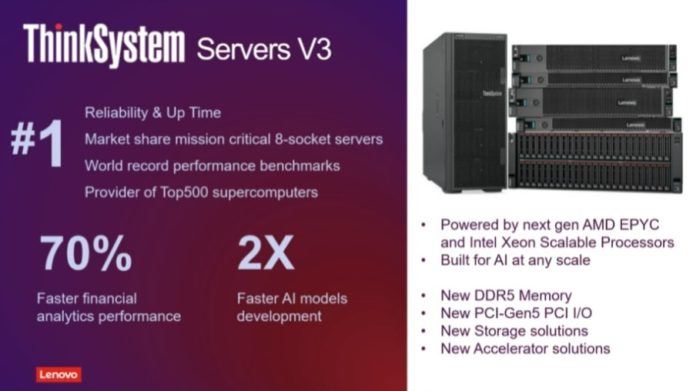At the Lenovo ThinkInnovation event, the company is announcing a massive number of new products. Even though the chips are not out, it is launching its new Intel Sapphire Rapids Xeon servers, AMD EPYC Genoa platforms, and Arm servers along with a host of new offerings. We asked Lenovo prior to the event, and while it does sell some Ampere Altra servers to cloud customers, it seems like the next-generation Arm servers that were mentioned in the press release for the event are Chinese market-only servers.
Note: This is being done live at the event, so please excuse typos.
Lenovo Launches Intel Sapphire Rapids AMD EPYC Genoa and Chinese Arm Servers
Lenovo has a number of announcements today covering the new servers, new XClarity One, and sustainability solutions.
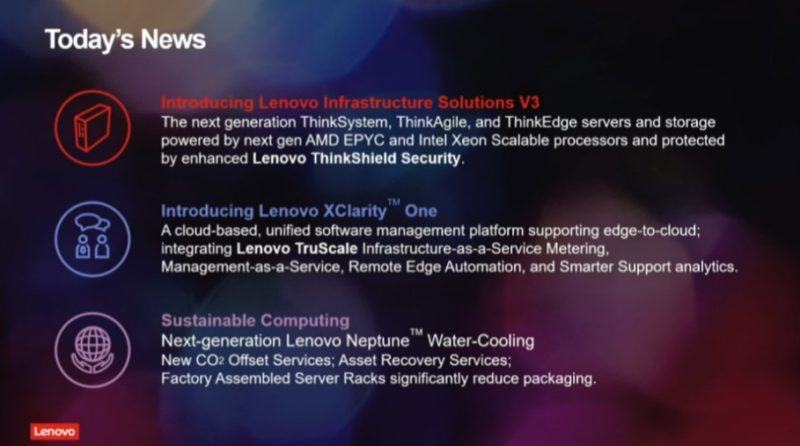
Lenovo is noting that it is growing briskly. One can see the impact of the domestic Chinese market’s new direction in using domestic hardware and that direction’s impact on Lenovo’s business.
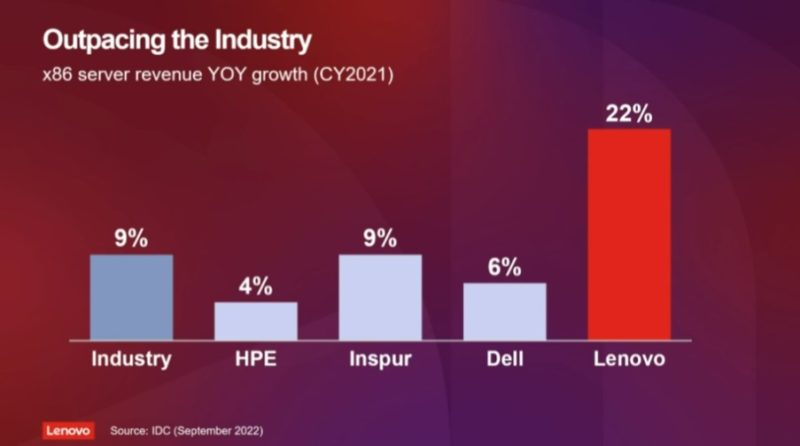
Lenovo is noting that its x86 servers are the most reliable. This is actually quite interesting as we have had challenges with HPE and Dell EMC servers in our own data center clusters. We purchased Lenovo servers to deploy, but they did not make it into production. That is a story we have not told on STH yet.
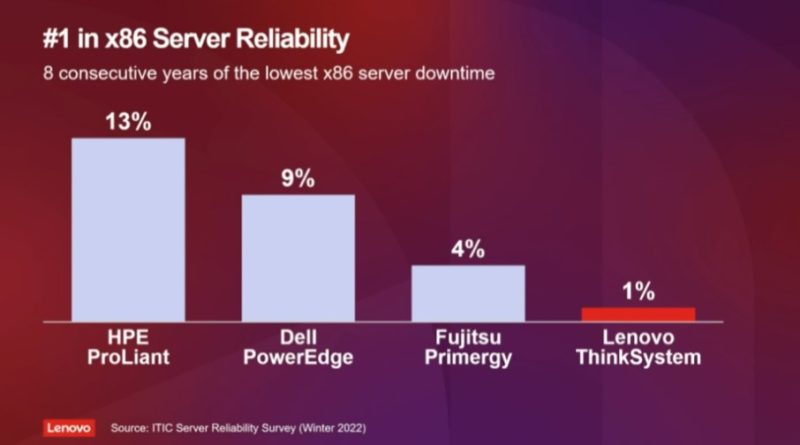
One that made us a little nervous is Lenovo’s claim of being #1 in Top500 supercomputers. The company answered our question at the event about why the ISC June numbers were not used (see our Top500 June 2022 new systems analysis.) The company said it was not because they fell from 180 to 162 systems from November 2021 to June 2022, but was because we are closer to the November 2022 list coming out, so they used November.
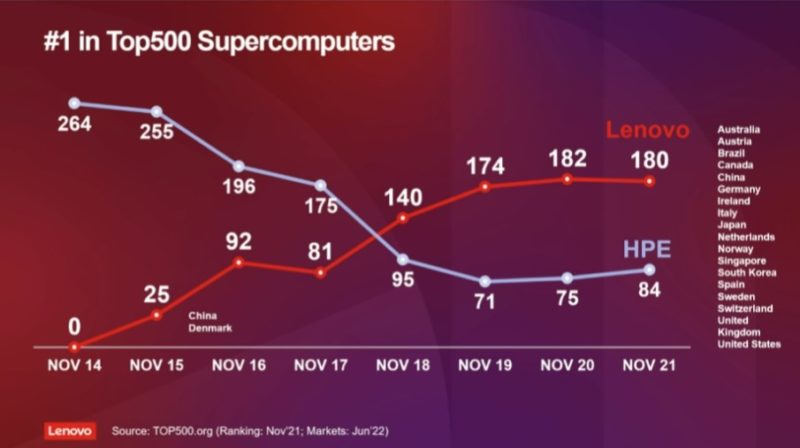
Some of this is due to Lenovo’s practice for Top500 systems. Lenovo, for years, has taken portions of hyper-scale installations in China with 10GbE interconnects, ran linpack on them, and then submitted them as Top500 systems before they went into e-commerce or other similar tasks. In our Top500 New Systems Analysis, we actually show these systems specifically.
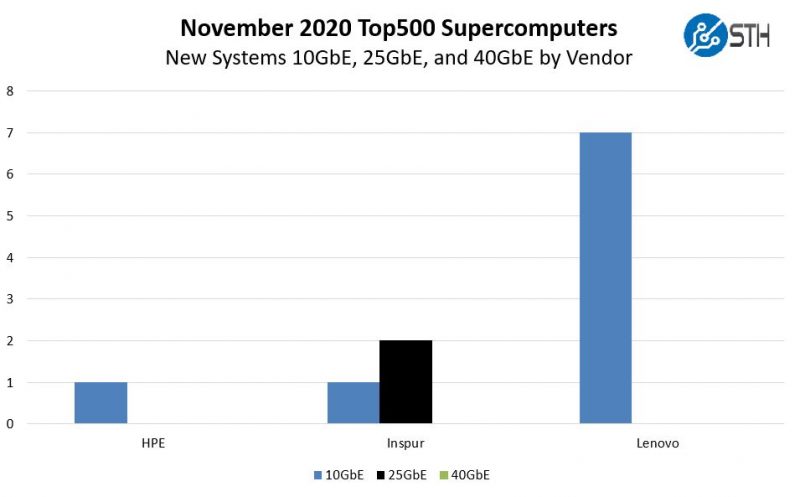
Just for some sense of scale, the 7 new 10GbE supercomputers on the November 2020 list shown as a data point seems small in the context of 500 machines, but this was out of only 44 new systems on the list. This strategy is how Lenovo is creating this dominant leadership even while HPE is delivering the US’s Exascale systems.
At the event, Lenovo said it is now designing its own motherboards and manufacturing motherboards Mexico, Hungary, and China. Here are all of the new platforms:
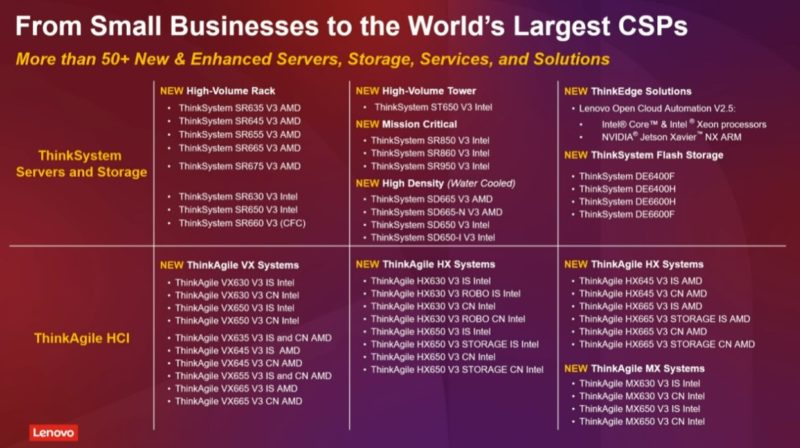
On the Lenovo ThinkSystem side, these will be the Intel Xeon Sapphire Rapids and AMD EPYC Genoa offerings with PCIe Gen5 and DDR5. For example, the ThinkSystem SR635 V3 is an AMD offering, while the SR630 V3 will be the next-gen Intel system.
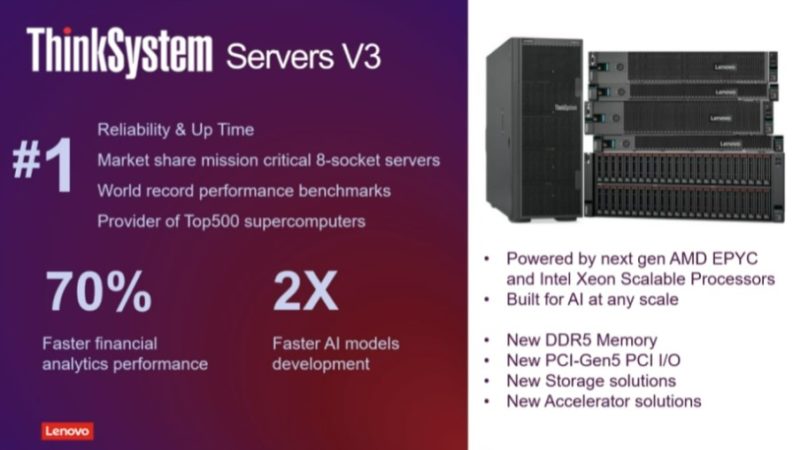
Lenovo has its Neptune platform for direct-to-chip liquid cooling. Previously, this was only for Intel products. Lenovo said its SR675 is an AMD-based 8x GPU server and is the best AI solution. That statement seems to lead to that it does not see Intel as competitive in the AI space, despite the NVIDIA DGX H100 using Intel Xeon Sapphire Rapids and having its own liquid cooling version.
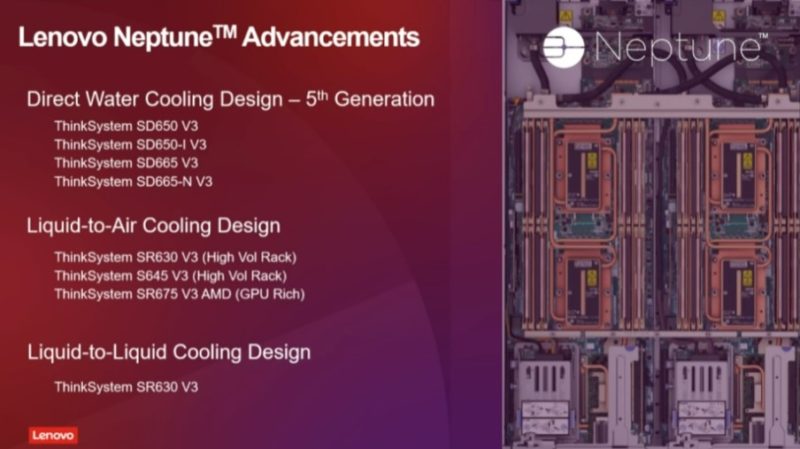
The other really interesting offering is that the ThinkSystem SR630 V3 (Intel Sapphire Rapids) is getting a version that has an internal closed-loop cooling solution. This is similar to a gaming PC with an internal cold plate, pump, radiator, and fans in a server. As a result, Lenovo can cool higher-TDP CPUs, but without requiring facility water. We showed off How Liquid Cooling Servers Work with Gigabyte and CoolIT earlier this year.
Lenovo is going after the entry storage array market with sub $25,000 offerings that make up around 60% of the systems shipped in the market. With that, Lenovo has new Enterprise DE series systems with all-flash and hybrid arrays.
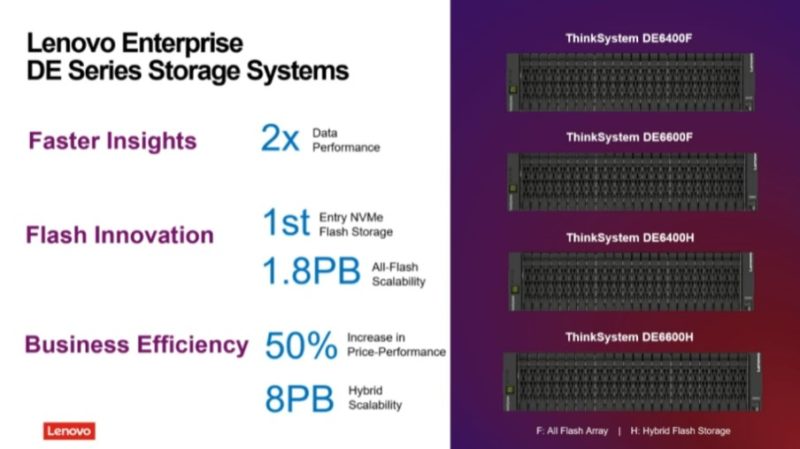
Lenovo has new hardware platforms, so it is also launching new solutions with Microsoft, Nutanix, and VMware as part of its ThinkAgile line.
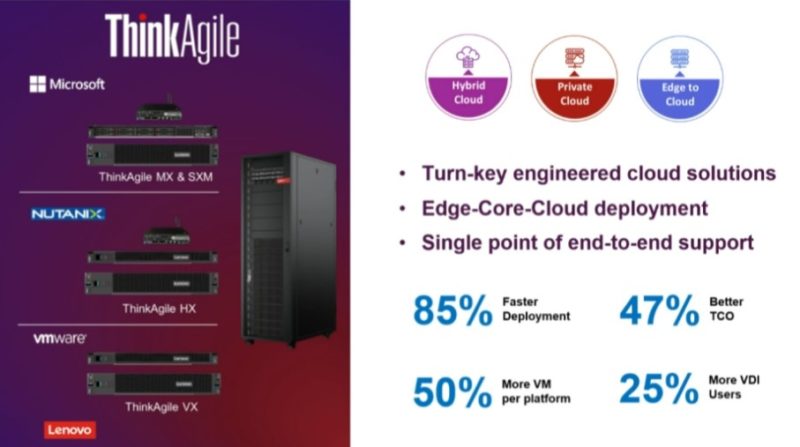
Lenovo has a new ThinkAgile MX solution set leveraging Microsoft Azure.
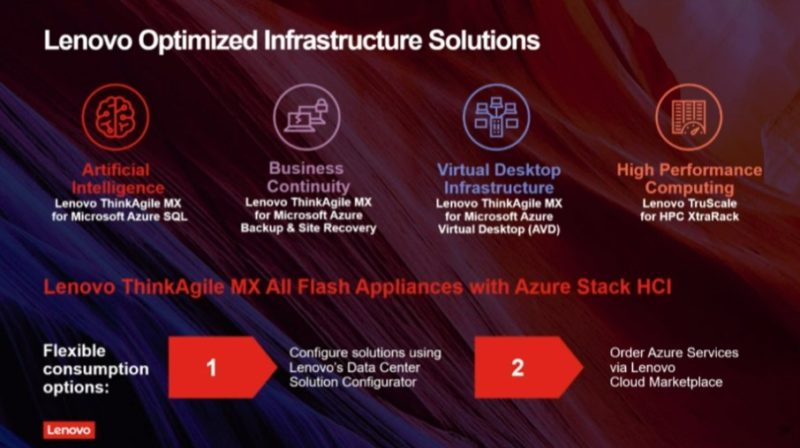
Here, one of the interesting points is that there is a HPC TruScale (hardware as a service/ consumption model) with a HPC XtraRack where HPC customers can add entire racks.
During the pre-briefing, the one I was most excited about was actually XClarity One. The company is building its XClarity management solution in the cloud. I asked about this, and Lenovo will ship solutions that can be installed at the edge, phone home to the XClarity One once connected, then provisioned. This is very interesting.
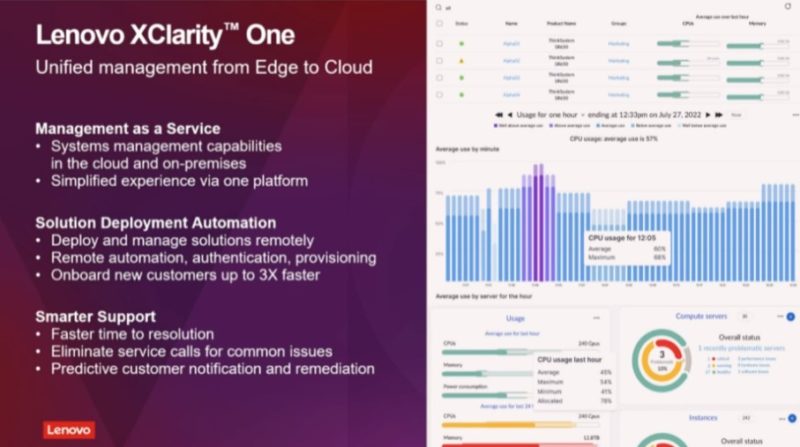
We requested screenshots, but Lenovo was unable to get them to us before going live with this piece.
Lenovo is focusing more on hardware security and ensuring supply chains from factory to installation.
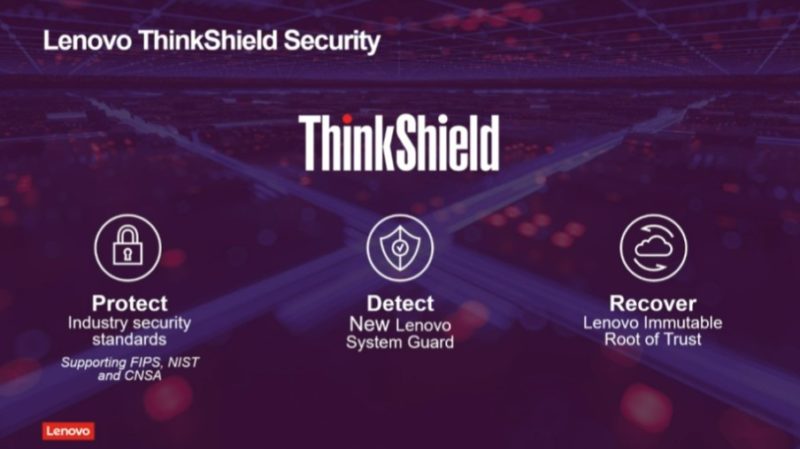
AMD PSB. Lenovo, along with Dell EMC, were among the first to use AMD PSB to vendor lock AMD CPUs. We found it in the company’s server, professional workstation, and desktop offerings.
It seems as though Lenovo is going to increase these efforts in the next generation.
On the Arm server side, we were hoping to get a good story. The event’s press release that the company shared prior to the event had a mention of next-generation Arm platforms:
“Lenovo Infrastructure Solutions V3 delivers advanced ThinkSystem, ThinkAgile, and ThinkEdge servers and storage with next-generation AMD, Intel and Arm-based processors…” (Source: Lenovo PR to STH)
Lenovo declined even to tell us which chips they are using. We would be shocked if these are the Huawei HiSilicon Kunpeng 920 Arm server CPUs we looked at. The Chinese market has been focusing on Arm servers lately. Lenovo as a Chinese server vendor, has been a major beneficiary of government focus on using domestic chips and IT equipment, so this makes sense that it is making more Arm-based servers. We wish the company opened up and shared those innovations with the rest of the world.
Final Words
Lenovo’s announcement is interesting. We can say that Intel Sapphire Rapids Xeon and AMD EPYC Genoa platforms are coming, but it seems like this announcement is quite a bit early. We also wish the company embraced being the second largest Chinese server vendor and showed off more innovation from that market.
Hopefully, we will see these soon. Lenovo told us they intend to ship systems when the embargo dates lift for the next-generation Intel and AMD platforms.

